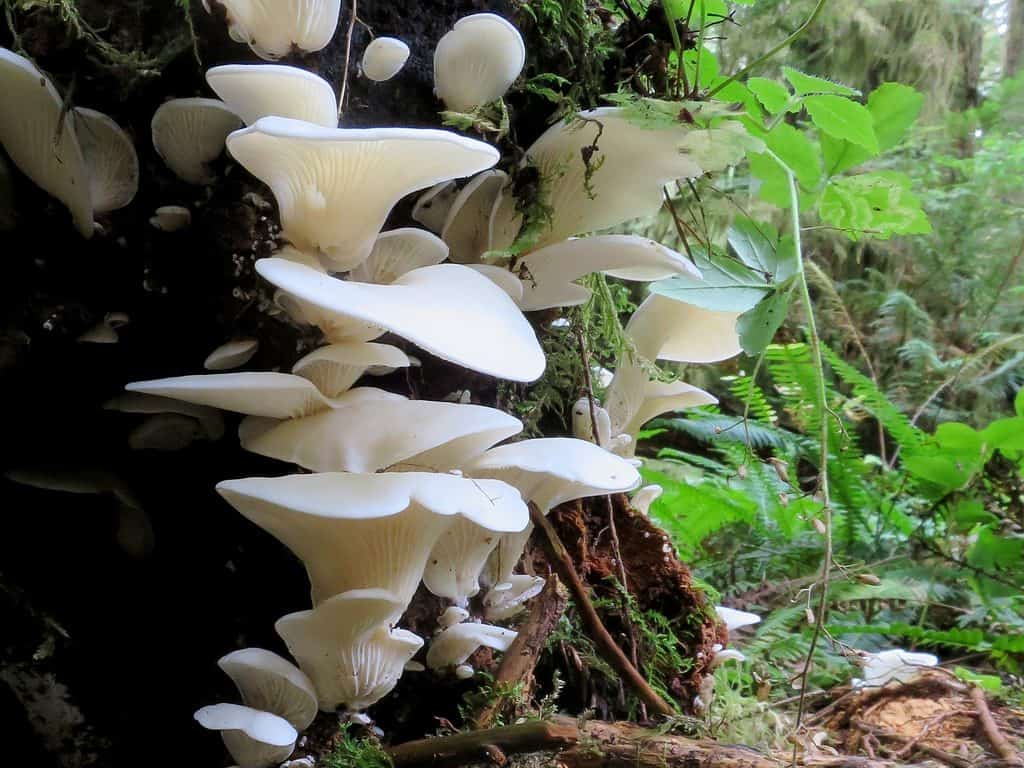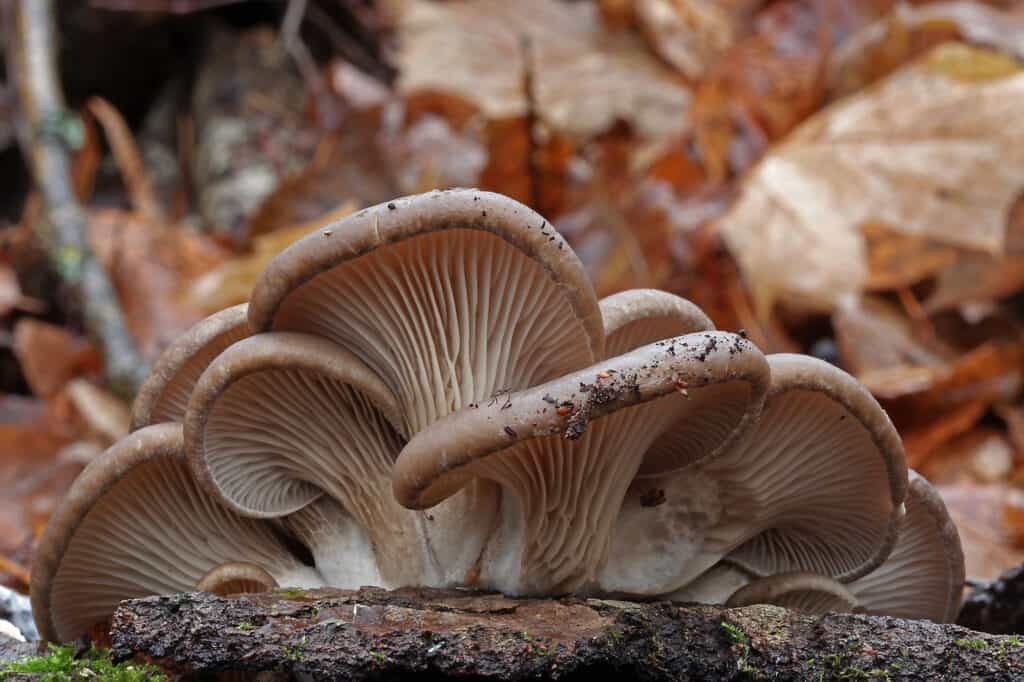Angel wing mushrooms- a delicate, beautiful mushroom with a complicated and confusing edibility status.
In this guide, we’ll cover angel wing mushrooms’ classification, growing regions, how to identify them, the confusion about their edibility status, and how to distinguish them from edible oyster mushrooms.
So, without further ado, let’s jump in!
Fungal Classification

Angel Wing Mushrooms –
Pleurocybella porrigens©Randy Bjorklund/Shutterstock.com
These lovely mushrooms are a part of the Phyllotopsidaceae family. Angel wing mushrooms belong to the Pleurocybella genus, and their scientific name is Pleurocybella porrigens. The Pleurocybella genus is notably small and contains only contains a few other species besides angel wings.
Mushrooms: Where Do They Grow?
You can find angel wing mushrooms growing in temperate conifer forests across the Northern Hemisphere. These mushrooms are saprobic, so they derive their nutrients by decomposing dead organic matter. In their case, they mainly decompose conifer trees.
These adaptable mushrooms grow from Japan across Eurasia to the conifer forests of Alaska and down into the continental US.
You’ll typically find Pleurocybella porrigens growing on rotting logs in dense, moist, heavily shaded forests.
How to Identify
To identify these lovely mushrooms, you’ll want to first look for clusters of overlapping mushrooms growing on rotting logs.
Check Out the Cap
You can easily spot this mushroom by how strikingly ivory-white the caps are. Additionally, while the morphology of the caps can vary, generally, they form a slight vase shape that stretches outwards at the margin (in a winged manner).
Typically, these mushrooms don’t grow larger than 4 inches across. The flesh of the cap should be notably thin.
The Gills
On angel wing mushrooms, the gills are decurrent, meaning they run down the length of the underside of the cap and stipe. This stipe may be quite rudimentary or even non-existent. The spore print color of Pleurocybella porrigens is white. The flesh of the gills is also delicate and thin, like the cap.
Angel Wing Mushrooms: Are They Edible?
The answer to the question of angel wing mushrooms’ edibility status is a bit of a complicated one. Field guides first described angel wings in 1805, and people have eaten them without recorded incident for centuries. Indeed, before 2004, most field guides listed this lovely mushroom as a good edible. So, then, what happened?
Well, in 2004 in Japan, 59 people became severely ill across nine prefectures, and the common denominator? They all ate angel wing mushrooms 13-29 days before the onset of serious neurological symptoms from acute encephalopathy (a degenerative neurological condition causing brain lesions). 17 people died, and all experienced a range of signs and symptoms, including the appearance of brain lesions, seizures, and hallucinations.
An important note in this poisoning case is that the average age of the poison victims was 70 years old, and all of those who died had preexisting compromised kidney function from kidney disease. In fact, all of the 59 elderly people poisoned had preexisting kidney disease. While scientists studying this series of poisonings in 2004 aren’t 100% sure of the cause, they tend to agree that having a compromised kidney before ingestion of the mushrooms seemed to play a role.
What Is the Deadly Toxin?
So, in 2010, a team of researchers identified an unstable amino acid in angel wings called pleurocybellaziridine, a strong candidate for the onset of acute encephalopathy in poisoning victims. In cell culture studies, this amino acid showed strong toxicity to rat brain cells.
You may be wondering why, if people have been eating these mushrooms for centuries (and likely indeed still are across the Northern Hemisphere), why we don’t see yearly cases of poisoning by angel-wing mushrooms?
One theory is that the angel wing mushrooms that flushed in 2004 were affected by a series of unusual weather events, including early typhoons, that caused them to flush in large quantities across Japan and to grow much larger than their average size. Researchers have found that the concentration of pleurocybellaziridine varies significantly by collection.
Thus, it’s possible that the concentration of this cytotoxin was particularly high in the 2004 flush and that the compromised kidney function of elderly people compounded this high concentration.
Since this series of poisonings in 2004, only one other event has been recorded. This poisoning also occurred in Japan, and the victim, who sadly passed away, was a 65-year-old man undergoing dialysis for advanced-stage kidney disease. Like the victims of 2004, he died of acute encephalopathy.
So, Then, Are Angel Wing Mushrooms Edible?
Ultimately, given the events of 2004 in Japan, the subsequent research on possible toxins, and the fact that people still widely eat this mushroom, the formal answer to the question of angel mushroom edibility at this point is that we don’t yet know. Many modern field guides choose to be cautious and advise foragers, especially with kidney disease, not to consume angel wing mushrooms.
Angel Wing Mushrooms: Distinguishing Them From Oysters

The clustered fashion that oyster mushrooms grow in may help with identification.
©NK-55/Shutterstock.com
Likely, you’ll want to learn how to Identify angel wing mushrooms so you can know how to tell them apart from the highly edible and sought-after oyster mushrooms.
While some species of oyster mushrooms, like king oysters, don’t resemble angel wings, other species, like the common oyster (Pleurotus ostreatus), certainly can. However, it’s not impossible to distinguish angel wings from oysters based on their macroscopic (what you can see with the naked eye) features.
Firstly, while some oyster mushrooms have white caps, they don’t tend to be as ivory white as angel wings. Instead, white oyster mushrooms have a more whitish-grey or whitish-brown appearance. The same can be said for the spore color. Pleurocybella porrigens spores are stark white, while Pleurotus ostreatus will be more off white to lilac colored.
Secondly, while angel wing caps tend to have a slight funnel or vase shape with winged margins, oyster mushroom caps typically have a more clam-shell or domed appearance.
Thirdly, while angel wings prefer to grow on conifer logs, most oyster mushrooms prefer to grow on hardwood logs. However, determining the type of log can be difficult if it’s already fairly decayed
Additionally, the flesh of oyster mushrooms is much thicker and less fragile than that of angel wish mushrooms.
Finally, oyster mushrooms can grow much larger than angel wings typically grow. So, if you’re in doubt about a flush of possible oysters, you can always wait and see how big the flush gets.
Up Next:
- Lobster Mushrooms: A Complete Guide
- Button Mushrooms vs. Baby Bella Mushrooms
- Matsutake Mushrooms: A Complete Guide
The photo featured at the top of this post is © Randy Bjorklund/Shutterstock.com
The information presented on or through the Website is made available solely for general informational purposes. We do not warrant the accuracy, completeness, or usefulness of this information. Any reliance you place on such information is strictly at your own risk. We disclaim all liability and responsibility arising from any reliance placed on such materials by you or any other visitor to the Website, or by anyone who may be informed of any of its contents. None of the statements or claims on the Website should be taken as medical advice, health advice, or as confirmation that a plant, fungus, or other item is safe for consumption or will provide any health benefits. Anyone considering the health benefits of particular plant, fungus, or other item should first consult with a doctor or other medical professional. The statements made within this Website have not been evaluated by the Food and Drug Administration. These statements are not intended to diagnose, treat, cure or prevent any disease.
Thank you for reading! Have some feedback for us? Contact the AZ Animals editorial team.






